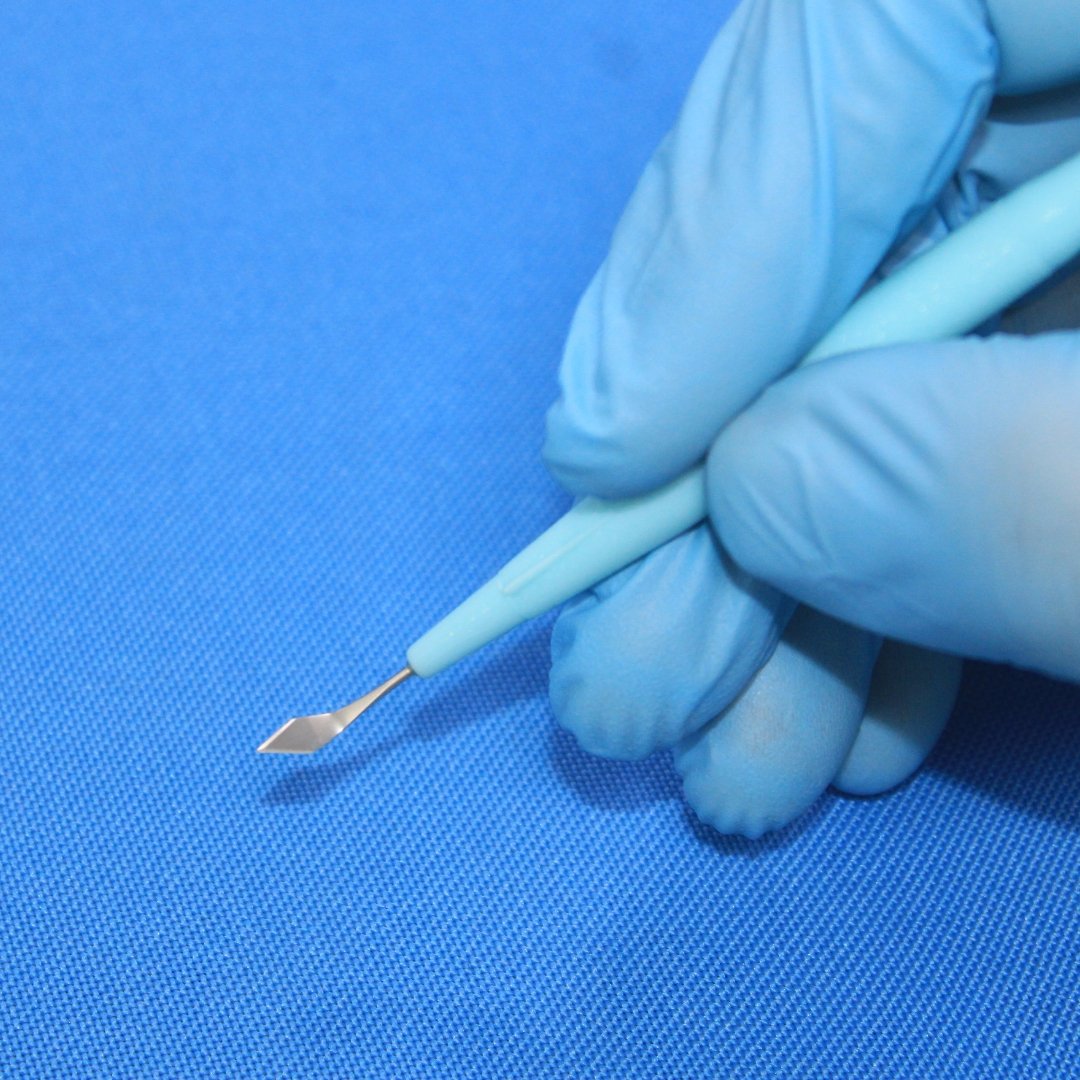Ophthalmic blades are used in highly specialized eye surgery that requires precision and delicacy. The many ophthalmic equipment, particularly surgical blades used to make incisions in the eye, are essential for obtaining this precision. Each blade type serves a distinct role, allowing advanced treatments to be performed with accuracy while causing minimal injury to surrounding tissues. The blade used in surgery can have a significant impact on the outcome, influencing factors such as incision depth, healing time, and overall success.
This article examines six types of blades typically used in ocular surgery, outlining their distinct functions and applications. Understanding these blades, which range from crescent blades for clean cuts to paracentesis knives for fluid drainage, improves surgical precision and patient safety. As ophthalmic instruments evolve, they play an increasingly important role in enhancing surgical results and advancing eye care procedures.
Importance of Blades in Ophthalmic Surgery
Blades are essential tools in ophthalmic surgery, specially designed for the precision required in microsurgical treatments. These surgeries frequently include sensitive structures like the cornea, retina, or lens, where sharp and beautifully constructed blades are required to reduce stress and ensure exact incisions. Choosing the right blade is critical not only for getting exact results, but also for avoiding hazards including excessive bleeding, infections, and long recovery times.
The importance of these blades is particularly evident in India, where ophthalmic care, including cataract procedures, is in great demand due to a large and expanding patient population. As a result, selecting and using proper blades from recognized ophthalmic tool suppliers is important for effective surgical outcomes. Continuous improvements in blade technology lead to increased safety and effectiveness in ophthalmic treatments, emphasizing the necessity of high-quality equipment in maintaining the highest standards of eye care.
#1: Crescent Blades
Crescent blades are useful tools in ocular surgery, especially for making partial-thickness incisions in the sclera or cornea. With their distinctive curved edge, these blades allow surgeons to make clean and controlled incisions in sensitive eye tissues. This design is especially useful for treatments like scleral tunnel development in cataract surgery, which require precise control over incision depth to achieve a good outcome.
Crescent blades are designed to limit tissue stress and the likelihood of uneven cuts, which can disrupt the healing process and lead to issues. Their adaptability enables them to be utilized efficiently in a variety of procedures, including manual small-incision cataract surgery (MSICS) and phacoemulsification. Crescent blades serve an important role in ensuring precise and safe surgical interventions in India, where cataract procedures are common, hence improving both procedure efficiency and patient recovery.
#2: MVR Blades
Micro Vitreoretinal (MVR) blades are useful in ocular surgery because they allow for precision sclerotomies, which are small, controlled incisions in the sclera, or the eye’s white outer coating. These blades are commonly employed in retinal treatments like vitrectomy, which necessitates open access to the vitreous cavity for optimal results.
MVR blades are distinguished by their sharp, tapered tips, which allow surgeons to move through the eye’s layers with minimal resistance. This precision is critical for treating difficult disorders such as retinal detachment and diabetic retinopathy, which are common in India. MVR blades contribute considerably to good surgical outcomes by allowing for accurate and smooth incisions, improving both the efficacy of the treatment and the whole recovery process for patients with major retinal problems.
#3: Stab Blades
Stab blades are important instruments in ophthalmic surgery because they are designed to generate small, precise incisions that allow for the use of other surgical tools. Stabbing blades, with their sharp, pointed tips, enable surgeons to make a clean, controlled entrance into the anterior chamber of the eye, which is required for several procedures.
During cataract surgery, stab blades are used to create access points for the phacoemulsification probe and irrigation system. Their design allows for less leakage and more precise incisions, which are critical for decreasing complications and speeding up healing. Because of their precision, stab blades are an essential instrument for achieving good results and a smoother recovery during eye treatments.
#4: Keratome Blades
Keratome blades are used to make accurate corneal incisions, particularly during cataract surgery. These blades feature fine, sharp edges and come in a variety of diameters to accommodate different types of incisions. They are primarily utilized to make a big corneal incision for cataract extraction and IOL implantation.
Keratome blades play a crucial role in cataract surgery in India, where age-related cataracts are prevalent. Their precision guarantees accurate incisions that allow for appropriate IOL placement, reducing postoperative complications like astigmatism and infection. Keratome blades facilitate cataract procedures and improve patient outcomes by allowing more detailed and precise incisions.
#5: Clear Cornea Blades
Clear cornea blades are useful in ocular surgery because they allow for self-sealing incisions in the cornea. These blades are extremely sharp and precise, allowing surgeons to create wounds that don’t require sutures. This characteristic is particularly useful in cataract and refractive surgery, where minimal postoperative intervention is required to reduce recovery time and infection risk.
Clear cornea blades excel in procedures like phacoemulsification because they can make smooth, self-sealing wounds. These blades have increased in favor in India, where more advanced cataract operations are in considerable demand. Their effectiveness not only contributes to the finest surgical outcomes but also significantly accelerates the healing process. Clear cornea blades help to accelerate recovery and enhance patient satisfaction by reducing the need for sutures and decreasing surgical complications.
#6: Paracentesis Knives
Paracentesis knives are specialist instruments that make tiny, precise incisions in the cornea or sclera during a variety of ophthalmic operations. These blades are very effective in paracentesis, which is a procedure for draining fluid from the anterior chamber of the eye. This medication is crucial for maintaining intraocular pressure, especially during glaucoma procedures, or balancing pressure after cataract surgeries.
Paracentesis knives are sharp and pointed, allowing surgeons to make very small incisions with minimal damage to the surrounding tissues. This precision is necessary for effectively managing illnesses such as glaucoma, which is common in India, as well as performing cataract surgeries with the best possible results. Paracentesis knives improve patient outcomes by allowing for accurate fluid drainage and pressure management.
Conclusion
Precision instruments, such as surgical blades, are required for successful eye surgery. Each blade – a crescent, MVR, stab, keratome, clear cornea, or paracentesis blade – has a specific purpose and allows surgeons to conduct complex procedures with extreme precision. Understanding the many functions of these blades is crucial for ophthalmologists and medical students, particularly in India, where access to high-quality ophthalmic surgery equipment is required to provide sufficient eye care.
As blade design and surgical processes advance, the future of ocular surgery appears brighter. These innovations help to ensure safer treatments, quicker recovery times, and improved overall patient results. Continuous innovation in ocular surgery instruments guarantees that eye care specialists may provide the best possible results, increasing surgical precision and overall patient care quality.
Shah Eye Care, a leading ophthalmic instruments company in India specialized in manufacturing ophthalmic microsurgical knives. Offering top-notch products and customized solutions through contract manufacturing and private labeling.












